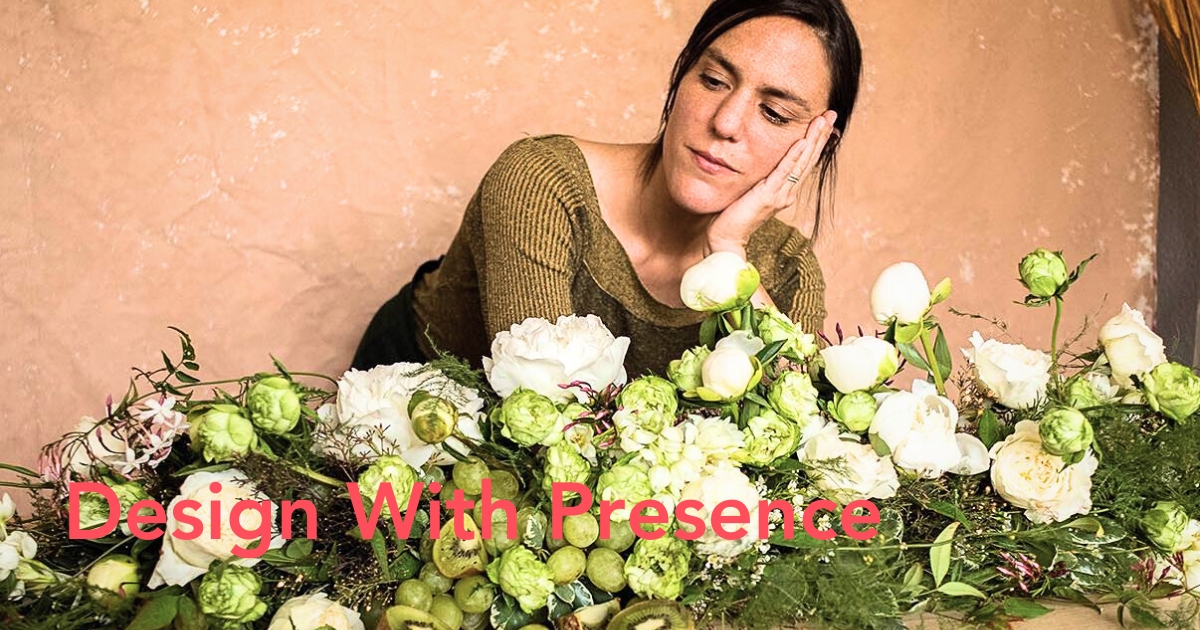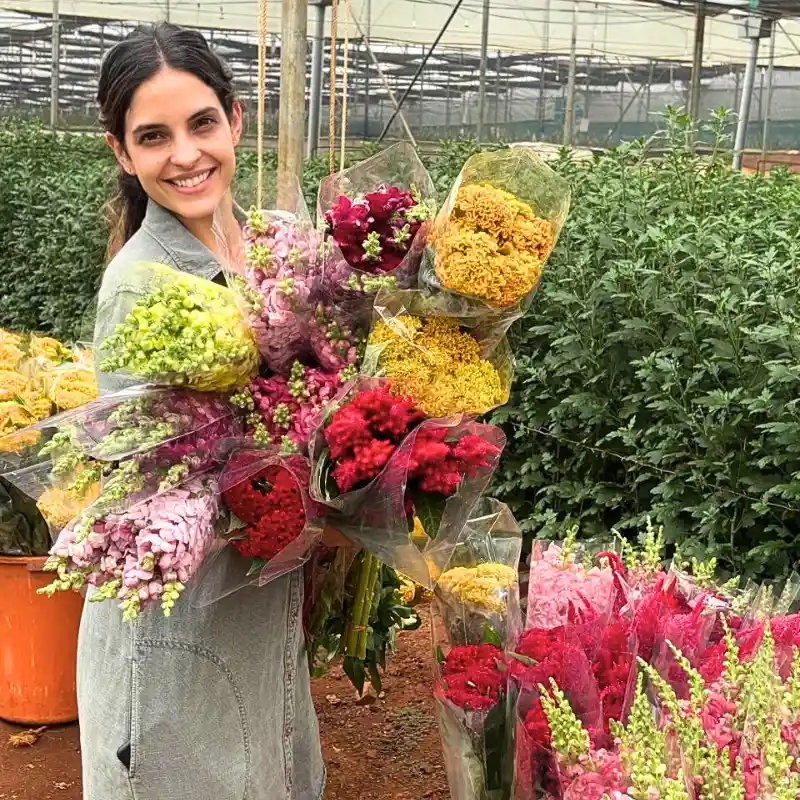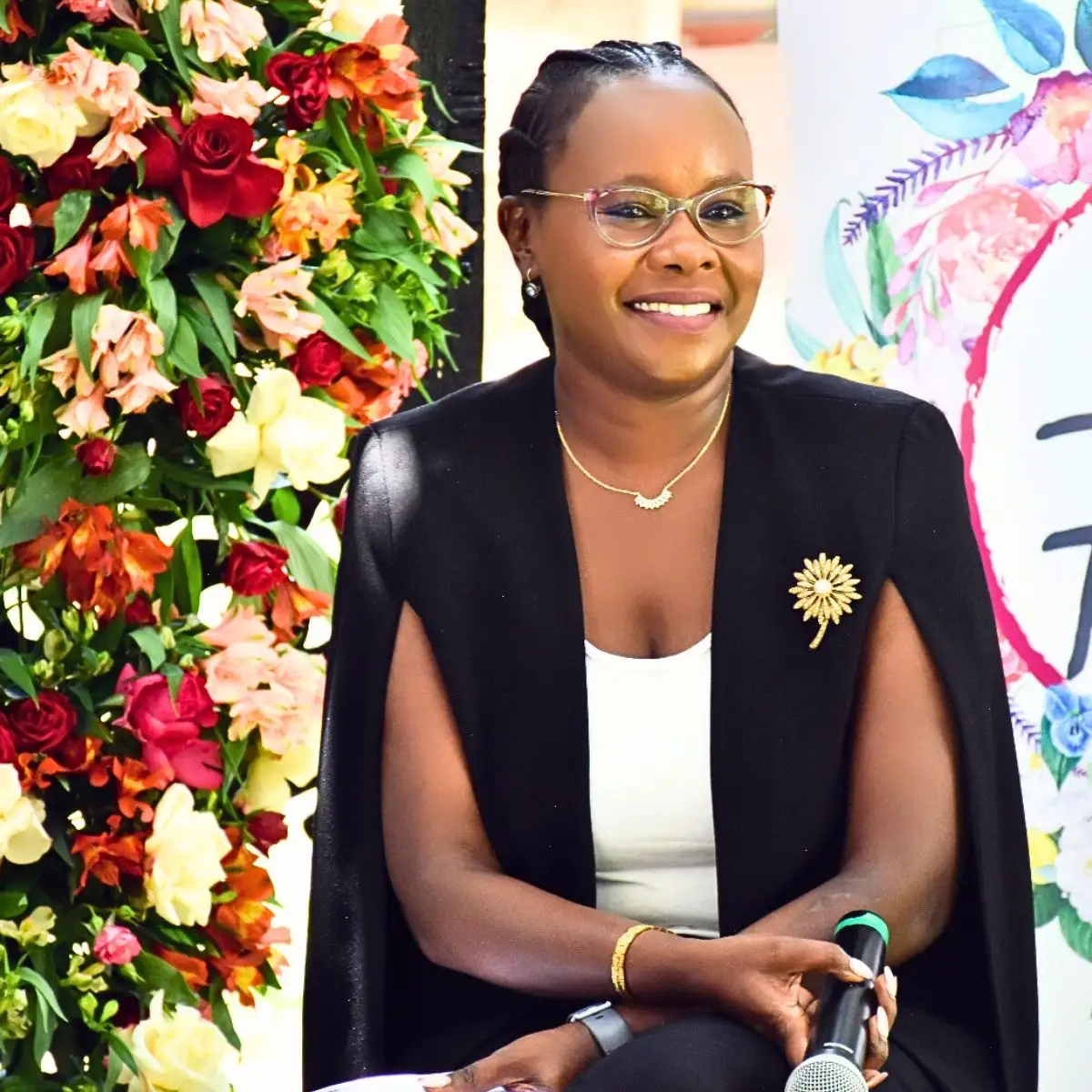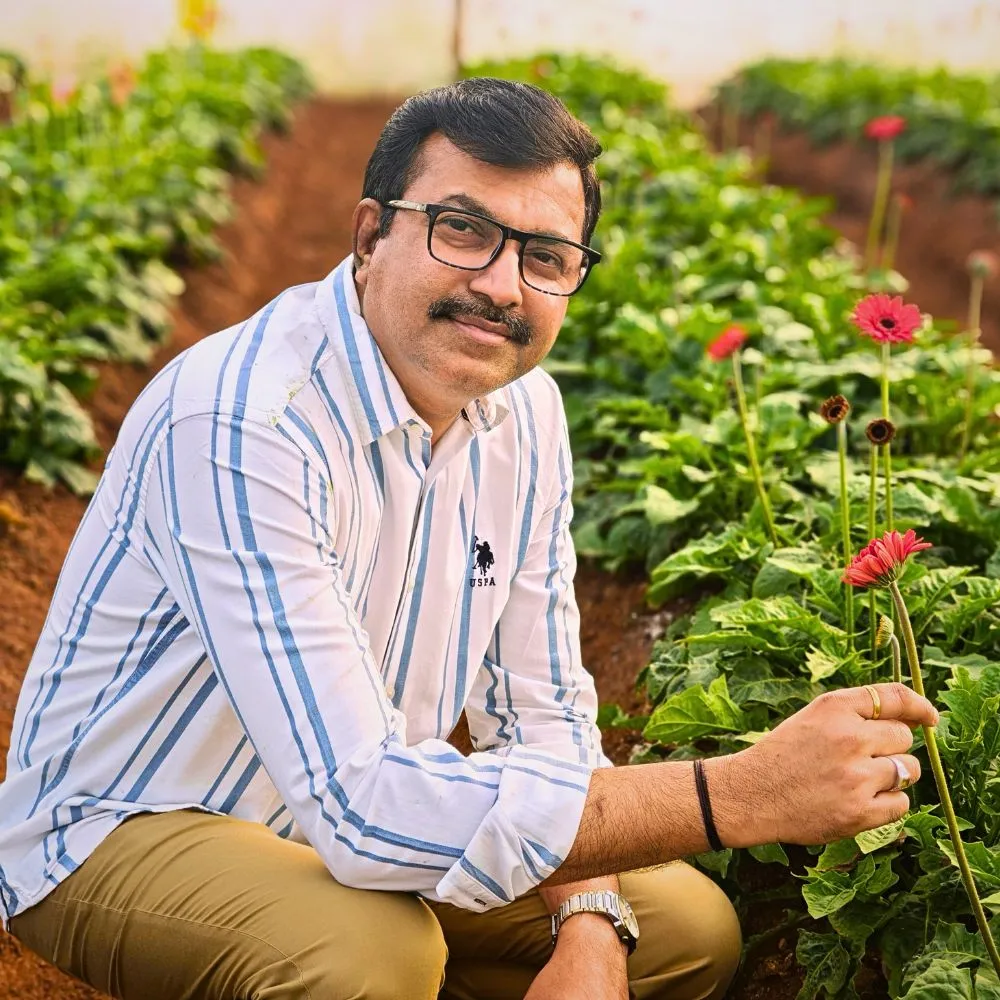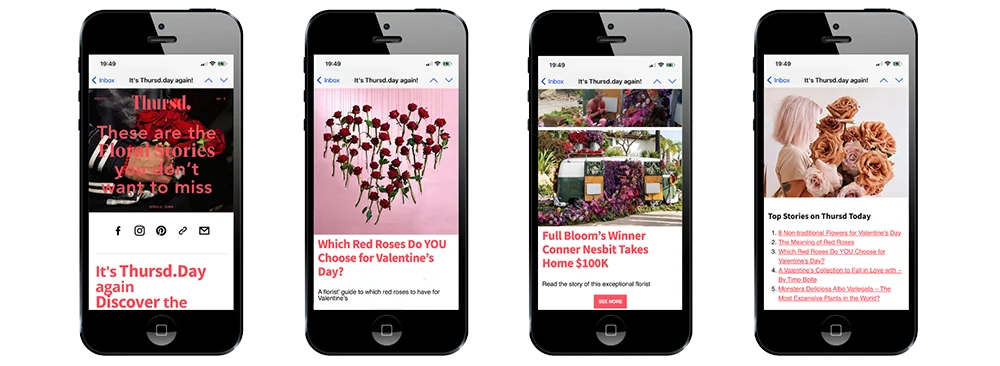Daniela Fabres works in a space where art, nature, and emotion meet. Her story begins on the Chilean coast, where the ocean and native forest shape the way she thinks, creates, and teaches. What she builds is not simply a floral design. It is a visual language that blends architecture, landscape, and a deep respect for natural materials.
In this week’s 10 questions, you will see how she formed her creative identity, the challenges she has overcome, the values that guide her work, and the shifts she observes in today’s floral world. You will also find her views on sustainability, community, inspiration, and the small rituals that keep her grounded. This is a glimpse into the mind of an artist who follows her own path with clarity and intention.
Question 1
For those who don’t know you, who are you and what do you do?
"I am a Chilean florist and visual artist based in Zapallar, a coastal haven where the Pacific Ocean meets native forest. Trained in visual arts, I have worked from the beginning at the intersection of ephemeral art and nature, through practices connected to land art and site-specific installations. I am deeply driven by a connection to both manual work and architectural thinking, and I explore the relationship between matter, space, and landscape.
After working as an art director in film, publishing, museums, and galleries, I founded Mise en Scène in 2008, now under my own name, a pioneering floral design studio in Chile, specializing in scenographies for immersive experiences with high technical standards and tailored to discerning clients. Since then, I have created hundreds of floral compositions and installations in Chile and abroad, a path that naturally led me to teaching.
Since 2013, I have taught courses in a variety of formats, levels, and techniques. In parallel, I have directed two concept stores and studio-workshops designed as curatorial environments where objects, flowers, tableware, and garden elements coexist, a reflection of my lifestyle and aesthetic vision."

Question 2
What is so special about your job?
"For me, being a florist is a way of seeing and experiencing the world. Working with nature as a source of inspiration and raw material is something that fulfils me completely. There's also the opportunity to go to different places, which I might not have seen through other means, and to travel, which is something that motivates me greatly.
I also enjoy intervening in a place, creating a setting where people participate in a sensorial experience that involves not only floral decoration but also space, time, senses, and emotions. And the relationship with people, and between people, has been central, as it creates the opportunity to gather, celebrate, and share important moments in their lives.
In addition, I’m interested in creating educational gatherings, collaborative projects, and community-based initiatives that expand the scope of floral practice, allowing for the exchange of knowledge, perspectives, and ways of making.
On the other hand, working with natural materials has a kind of quiet magic for me. It shifts me out of an overly analytical mindset and into a way of thinking that happens through the hands. Through that process, I’m able to express myself more freely, and it gives me moments of genuine presence and connection, moments that follow a different rhythm altogether."

Question 3
Are there any specific challenges or obstacles you’ve faced in your job, and how did you overcome them?
"One of the biggest challenges in my career has been the administrative side of the work, especially accounting. With a background in visual arts, I had almost no foundation in this area, so I learned everything through trial and error and by seeking advice from experts. Surprisingly, sales came much more naturally to me. Today, I feel confident in that aspect, largely thanks to experience gained through practice, ongoing work, and direct interaction with clients. I also have to acknowledge something I like to call my family’s entrepreneurial gene: the ability to turn a creative field into a livelihood. Living through all the ups and downs that come with that is, in the end, a way of life, a kind of character-building that allows you to continue pursuing what you love.
Marketing, on the other hand, has never felt intuitive. I know it is important, but I’ve always approached it organically, staying true to who I am. Partnerships, word of mouth, and face-to-face connections have been my strongest channels, and they have kept my work flowing without relying on big campaigns. People who follow my work value that consistency, and over time, it has allowed me to gain creative freedom and focus more deeply on the aspects of the discipline that truly define me, something that took time, but has been incredibly rewarding."

Question 4
What are the threats in the industry, and if so, do you have any solutions for them?
"When it comes to sustainability, I feel our industry still has a long way to go. There is awareness and intention, but much less actual implementation. One area that remains largely overlooked is the management of organic waste: so much of what we discard could be composted and returned to the soil, even supporting the very flower crops we work with. Completing this circular loop would require bringing in professionals from adjacent fields, environmental management, composting, biomaterials, who can offer the technical expertise we currently lack.
Another urgent frontier is packaging. There is a whole world to explore in recycled, biodegradable, or bio-based materials to replace what is commonly used today.
From a design perspective, we also need to rethink how to give a second life to our installations and choose materials that are aligned with our times. If we work with nature, our daily practices must reflect respect for it. And finally, we need to elevate the perception of our profession. Floral designers provide a skilled service that requires physical effort, creativity, and clear added value. Yet in Chile, it’s still common for clients to ask for discounts, as if our work were less legitimate than that of other professionals. Educating the consumer to understand and pay fair value is part of the change we need. I believe in education as a way to carry out these and other initiatives that not only train new generations in their practice but also educate potential consumers."

Question 5
How has technology like e-commerce platforms or digital marketing affected your industry? Which strategies have you employed to stay competitive?
"As I mentioned earlier, my marketing approach has always been very organic and rooted in direct client relationships. With social media, I’ve seen how visual trends become homogenized, and commissions start to look alike. My response has been the opposite: interpreting each brief through my own language and returning a proposal that meets the request while staying true to my personal signature.
I know I’m not part of the mainstream, nor is that my intention. I’ve been deliberate in choosing my clients, and many of them return. I always deliver a well-crafted product with a clear personal touch, regardless of scale. I prefer to stay boutique rather than become mass-oriented, maintaining as much creative freedom as possible and charging fairly for the work I do."

Question 6
Who (in or outside the floral industry) is an inspiring example to you? And Why?
"Historically, I’ve always looked beyond flowers for inspiration. Architecture, dance, visual arts, and film have been the fields that nourish me and allow me to return to floral art with a broader perspective. Being a very visual person, certain works have marked me deeply: for example, the projects of Christo and Jeanne-Claude, the cuts of Gordon Matta-Clark, the land art of Andy Goldsworthy, the architecture of Tadao Ando and Mies van der Rohe, or the films by Jim Jarmusch, Paolo Sorrentino, and Terrence Malick, as well as the work of choreographer Pina Bausch.
At the same time, I come from a family history full of creatives on both sides, ballet dancers, architects, ceramicists, which has inevitably shaped who I am. My grandparents, with their vision and drive, left a legacy that is impossible to ignore. In the floral field today, I admire people who are building projects and initiatives that connect others in the industry, opening spaces for conversation, debate, and meaningful encounters that strengthen networking and collaboration among peers. I believe in less ego and more community. Projects like Flower House Mexico, led by the brave and wonderful Pili Fuentes, follow this path: education tied to a social purpose, creating opportunities for connection and bringing a region to life through flowers every time an edition takes place.

I also admire artists who remain very true to their own line, those who allow themselves to explore, and even to transgress, without seeking to provoke, but instead with elegance, subtlety, and a clear artistic statement. Cases like Wagner Kreusch or This Humid House, and the way they have built and consolidated their journeys, resonate deeply with me and move me on an emotional level."
Question 7
How do you handle stress or difficult moments in your life?
"For me, staying as close to nature as possible is essential. I often take long walks along the coast, among the rocks and sand, and I try to breathe deeply whenever I can throughout the day. Before going to sleep, I make an effort to honor my rituals; facial massages, stretching, and keeping some distance from electronic devices. I care a lot about my sleep, as well as my nutrition. It has taken me time to reach a certain balance, but I no longer compromise by eating whatever I find on the go; I make space to sit down and have my meals, no matter how rushed a day might feel.
I try to integrate these habits into my life consistently, not only when stress is already too high. One must know how to perform, but also how to pause. I hope to deepen this awareness even more, taking better care of my body, because I know it gives me the well-being I need to face demanding moments. And all of this helps me stay in harmony, and also keep on learning how to soften my own expectations so I can truly enjoy the process."

Question 8
What has been the best (floral or non-floral) news for you lately, or of the last year?
"Seeing new trends emerge has been fascinating. We’re finally moving away from the Golden-Age-inspired style or the purely Constance Spry–like arrangements, very romantic, asymmetric, and close to the garden style (don’t get me wrong, I like them a lot, but I had grown tired of seeing them everywhere).
Since last year, I’d say we’re witnessing something more contemporary and theatrical: tables set in shapes that challenge the classic round, rectangular, or long formats of previous years, giving way instead to serpentine or circular configurations. There’s also a bolder, more monochromatic use of color, and designs that incorporate a full scenographic approach—one that dialogues with the food itself. This includes new ways of serving and creating experiences, and even the integration of fruits and vegetables into the arrangements.
At first, I wasn’t sure what to think, whether I liked it or not. And I still find myself questioning the phenomenon: is it a post-pandemic desire for more spectacle? A shift in how we gather, celebrate, and eat? A kind of baroque-yet-minimalist aesthetic, strangely aligned with an AI-like, dreamlike future? Many questions arise when thinking about these new avant-garde directions. I still don’t know if I love them, but I do find them refreshing and interesting. And on a personal note, I’m thrilled to become an aunt for the second time, this time to a baby girl, whom I will surely spoil and gently influence with flowers."

Question 9
Which is your favorite flower and why?
"I’m not really a fan of having “favorite flowers.” Each one has its own character, and I’m often surprised by the possibilities they offer, whether because they match a certain mood or allow me to express something specific in a design. I’m always open to using any flower as a medium of expression. The same happens with color: a shade I wouldn’t have chosen at one moment suddenly becomes very present at another. In cut flowers, my palette is varied and versatile; I focus more on the overall composition, the message, the mood, the combination, the shapes, and the textures I can create.
That said, there are flowers I love for deeply personal reasons: the citrusy scent of jasmine, the camellias that remind me of my grandmother, the magnolia of my childhood that grew beside my home, or the mimosa whose flower announces the arrival of spring."

Question 10
What are you doing this weekend?
"A mix of activities! I was asked to create floral arrangements for a brand’s stand at a trade fair. I was also invited to teach a workshop on sustainable techniques at a nature-focused event, where I’ll guide participants in designing and assembling a couple of group pieces.
At the same time, I’m preparing for the end of the year, refining proposals for window displays and working on a beautiful commission for a permanent installation in a new Japanese restaurant.
Since it’s high season, my weekends are usually spent working or simply recovering from the week’s installations. But I’m happy to be moving forward with projects that align so closely with my interests."

Daniela’s story invites us to look at floral design through a wider lens, one shaped by landscape, intuition, and a steady commitment to meaningful work. Her reflections on creativity, sustainability, community, and personal rhythm offer a thoughtful reminder that this industry grows stronger when voices like hers are heard.
If you found her journey insightful and you know individuals or thought leaders whose stories deserve to be featured, you are welcome to share your recommendations. Send them directly to edwin@thursd.com so we can continue highlighting the people who shape and inspire our floral world.
Pictures by Daniela Fabres.

